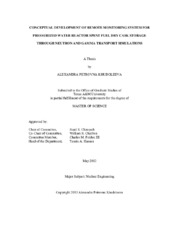| dc.description.abstract | The International Atomic Energy Agency (IAEA) needs to enhance its capabilities for safeguarding spent nuclear fuel (SNF) stored in dry cask storage facilities and for maintaining persistent continuity of knowledge (CoK) about it. The current safeguards approach relies heavily upon containment and surveillance measures, where seals are placed inside and outside the dry cask. The disadvantage of this approach is that, if a seal is broken, no method currently exists to verify the dry cask content other than opening it and checking the internal seal and the SNF inside. This is a costly and difficult activity. Thus other measures need to be developed. This study focused on the development of a remote monitoring system (RMS) for dry cask storage which is capable of detecting neutron and gamma radiation emitted by the SNF and the signal thus generated can then be continually transmitted to the IAEA to maintain the CoK about the dry cask content. The remote option was chosen after reviewing the current IAEA needs.
A computational approach was used to develop the proposed RMS. Monte Carlo N-Particle transport code (MCNP) was employed to develop a dry cask model with 32 SNF assemblies inside. The ORIGEN-ARP, fuel burn-up and depletion code, was used to generate a radiation source-term. A series of MCNP simulations were performed to investigate the neutron and gamma flux behavior inside the dry cask. The results of these simulations aided the design of the RMS and determination of the optimal location for its components. The RMS was placed inside the dry cask on the top of the multi-purpose canister (MPC). The final conceptual design of the RMS included two fission chambers (to detect neutrons) and one ionization chamber (to detect gamma radiation) enclosed in a polyethylene box with a thin cadmium plate inside, so the sequence of layers starting from the MPC lid was: polyethylene bottom layer, cadmium plate, chambers enclosed in polyethylene and polyethylene layer on top. Such configuration provided a suppression effect for thermal neutron flux coming from the bottom SNF assemblies and made system more sensitive to the opening of the dry cask lid and removal of SNF assemblies from the peripheral MPC cells. The proposed RMS design was tested through diversion analysis. The fission chamber unit design was successfully able to detect all the SNF diversion scenarios studied. The ionization chambers were able to detect only removal of SNF assemblies located just below it. However, the ionization chamber was found to be able to identify the opening of the dry cask lid through reduction in signal whenever the lid was opened. Therefore, the ionization chamber was kept in the RMS design to provide secondary confirmation for the detection of dry cask lid opening. | en |


